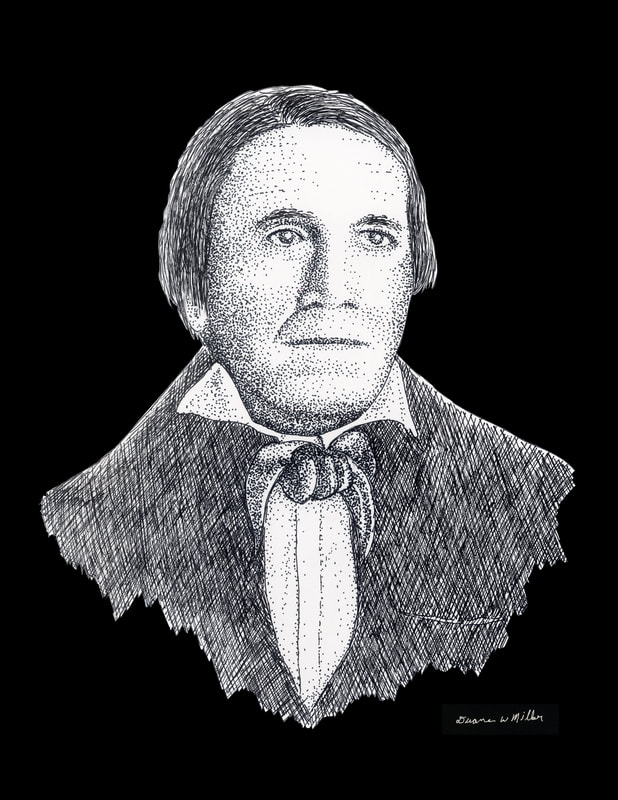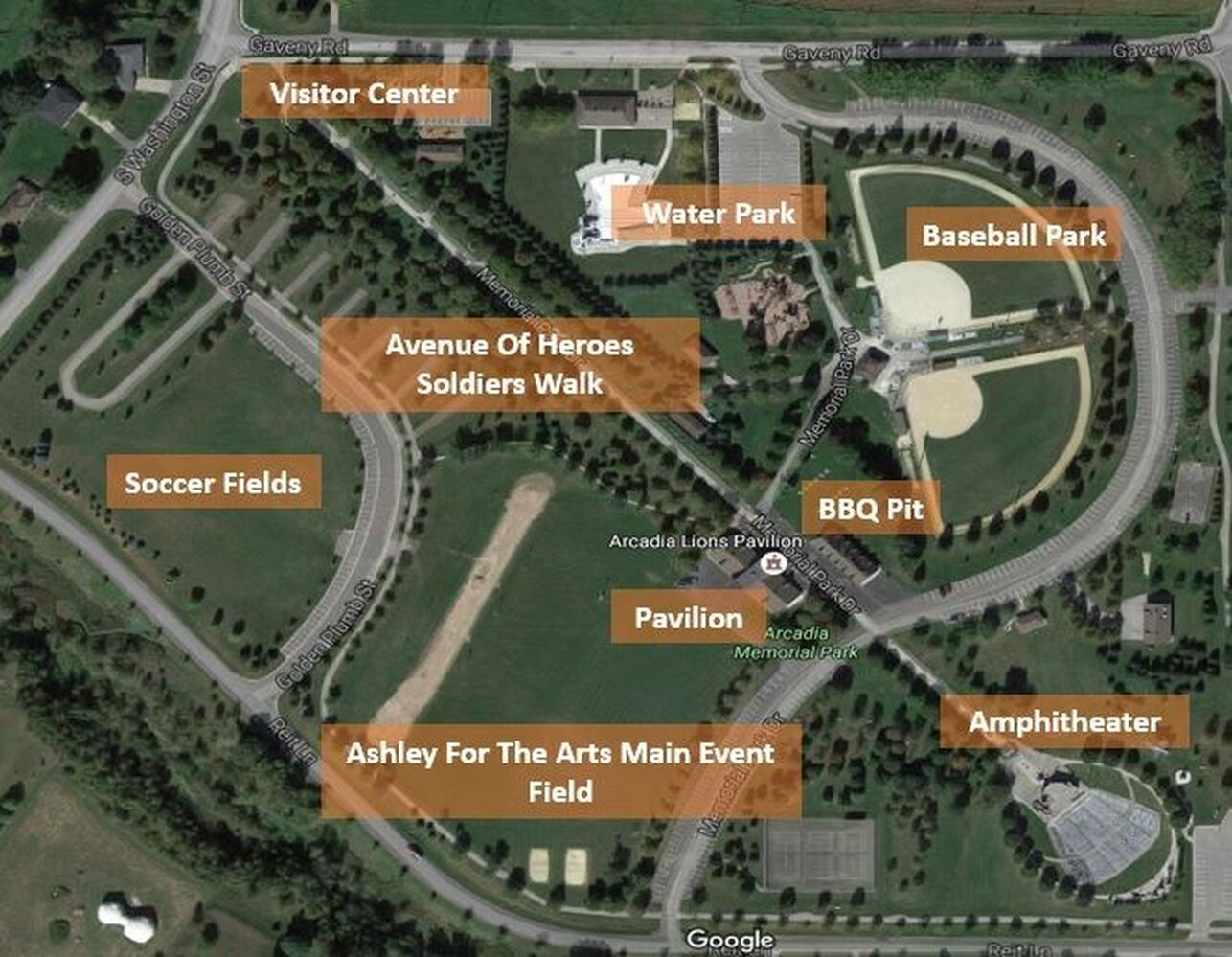james reed - the First Permanent Settler in Trempealeau County and Founder of Trempealeau.
The statue is located at the end of the park in front of the Amphitheater
James Reed was born in Kentucky to Scotch-Irish Pioneers. As a child, he heard with delight the stirring tales about the western frontier; trapping, trading, the forests, rivers, and tales of the Indian culture.
James Reed was a man of medium height, with broad shoulders and a large chest. He had light brown hair and grayish blue eyes. He was a quick, active man, alert and ready for any emergency. He often dressed like the Indians with a blanket thrown over his shoulders and fastened around his waist with a belt. Whether out hunting, trapping or on one of his numerous journeys, Reed always rode with his rifle across the pommel of his saddle. In disposition, he was a kind and gentle person. He was a man of the frontier and adapted to its demands; while his firmness and fairness won for him the respect of all his associates.
Like most children of the frontier era, he was not educated when it came to books, but he was adept in the school of nature. He adapted quickly to the local customs, speaking French as well as several Indian dialects. To the To the French he was known as Reed Americain; while by many, because of his military record, he was called Captain Reed.
While on his journeys up and down the Mississippi while working for The American Fur Company he often remarked about the beauty and location of Trempealeau and had decided to locate there whenever a favorable opportunity should offer. Circumstances delayed him until 1840 when he had chosen the site for a town and had in view plans for a future. In the summer of 1840, he built a log house on his well-selected site a few yards from the bank of the Mississippi moving his family to make this his permanent home. Reed was the First Permanent Settler in Trempealeau County and Founder of Trempealeau.
At the first town election held April 1851, in La Crosse, James Reed was elected justice. Trempealeau was then included in La Crosse County. Whether there were any cases for the justice court during Reed's term of office is doubtful. Differences were likely to be settled in the more primitive way of hand to hand encounters, and if this failed an appeal to the higher court of firearms was initiated.
Reed was an expert in the three “T’s of the era:
James Reed was a man of medium height, with broad shoulders and a large chest. He had light brown hair and grayish blue eyes. He was a quick, active man, alert and ready for any emergency. He often dressed like the Indians with a blanket thrown over his shoulders and fastened around his waist with a belt. Whether out hunting, trapping or on one of his numerous journeys, Reed always rode with his rifle across the pommel of his saddle. In disposition, he was a kind and gentle person. He was a man of the frontier and adapted to its demands; while his firmness and fairness won for him the respect of all his associates.
Like most children of the frontier era, he was not educated when it came to books, but he was adept in the school of nature. He adapted quickly to the local customs, speaking French as well as several Indian dialects. To the To the French he was known as Reed Americain; while by many, because of his military record, he was called Captain Reed.
While on his journeys up and down the Mississippi while working for The American Fur Company he often remarked about the beauty and location of Trempealeau and had decided to locate there whenever a favorable opportunity should offer. Circumstances delayed him until 1840 when he had chosen the site for a town and had in view plans for a future. In the summer of 1840, he built a log house on his well-selected site a few yards from the bank of the Mississippi moving his family to make this his permanent home. Reed was the First Permanent Settler in Trempealeau County and Founder of Trempealeau.
At the first town election held April 1851, in La Crosse, James Reed was elected justice. Trempealeau was then included in La Crosse County. Whether there were any cases for the justice court during Reed's term of office is doubtful. Differences were likely to be settled in the more primitive way of hand to hand encounters, and if this failed an appeal to the higher court of firearms was initiated.
Reed was an expert in the three “T’s of the era:
Trapping, Trading & Tomahawkin
Reed could follow a trail, wield a hunting knife, and throw a tomahawk with more cunning than most of the native Indians. As a rifleman, his accuracy was renowned and feared by those who crossed him, even on the western frontier where every man was considered an expert.
Reed spent much of his life in the military, enlisting in the war of 1812 in November 1814. He was later posted at Fort Crawford on the Mississippi River, near Prairie du Chien, where he met and married a woman from the Chippeway Tribe and had 5 children with her before she died in 1830.
Reed had always wanted to be a fur trader, so he went to work for the American Fur Company after his discharge. The animals he preferred trapping in the region were muskrat, mink, marten, otter, raccoon, and beaver.
It was during this period in his life he met and married his second wife Agather Wood, a Menomonee mixed-blood woman and had two additional children with her before she passed away. Reed built a log house and moved his family to the banks of the Mississippi, in what became known as James Reed's Landing and eventually Trempealeau as we know it today. Reed was also appointed as the first La Crosse County judge. At the time of his appointment, Trempealeau was part of the Lacrosse County.
In 1844 he married his third wife, Archange Grigon. Reed obtained the position of government farmer for the Wabashaw Indians living on the present site of Winona, MN, where he and L.H. Bunnell erected the first house built in Winona.
Reed hunted and trapped in the Dodge and Arcadia areas for years before he died at the home of his friend and neighbor, Charles H. Perkins in1873 at the age of 75.
Reed spent much of his life in the military, enlisting in the war of 1812 in November 1814. He was later posted at Fort Crawford on the Mississippi River, near Prairie du Chien, where he met and married a woman from the Chippeway Tribe and had 5 children with her before she died in 1830.
Reed had always wanted to be a fur trader, so he went to work for the American Fur Company after his discharge. The animals he preferred trapping in the region were muskrat, mink, marten, otter, raccoon, and beaver.
It was during this period in his life he met and married his second wife Agather Wood, a Menomonee mixed-blood woman and had two additional children with her before she passed away. Reed built a log house and moved his family to the banks of the Mississippi, in what became known as James Reed's Landing and eventually Trempealeau as we know it today. Reed was also appointed as the first La Crosse County judge. At the time of his appointment, Trempealeau was part of the Lacrosse County.
In 1844 he married his third wife, Archange Grigon. Reed obtained the position of government farmer for the Wabashaw Indians living on the present site of Winona, MN, where he and L.H. Bunnell erected the first house built in Winona.
Reed hunted and trapped in the Dodge and Arcadia areas for years before he died at the home of his friend and neighbor, Charles H. Perkins in1873 at the age of 75.
surrounding the statue are engraved pavers highlighting Reed's storied life
there is a second statue of james reed on the river at the town of trempealeau.
download the james reed informational brochure
| jame_reed_brochure.pdf | |
| File Size: | 1202 kb |
| File Type: | |




